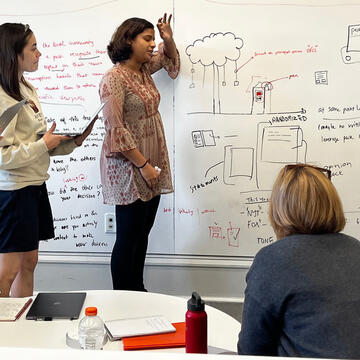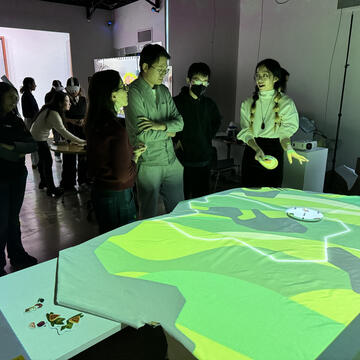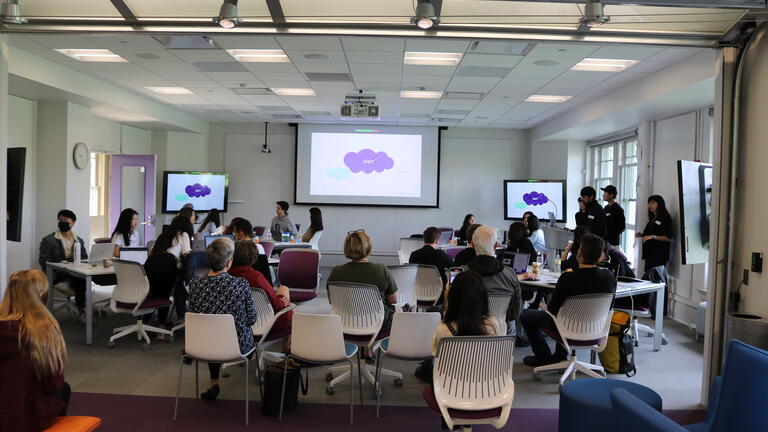Master's Degrees at the School of Design
The School of Design is committed to offering students a world-class graduate-level design education through our three master's programs—Master of Art in Design, Master of Design in Design for Interactions, and Master of Professional Studies in Design for Interactions (for MA students only).

We take a values-centered approach to design.
Design is a highly interactive and transdisciplinary endeavor that is integral to the success of businesses and organizations worldwide. Leaders in the field increasingly collaborate to develop products, services, and systems that significantly impact ways of life, which places great responsibility on designers. In the School of Design at Carnegie Mellon, we understand the important roles that design can and should play in the world. Carefully considering the implications of our actions, we practice a values-centered approach to design and strive to develop thoughtful solutions to improve the quality of life for people and the planet, today and in the future.
We work in the face of ambiguity.
Contemporary challenges and opportunities are often ambiguous and complex. Rather than shy away from ill-defined situations, our graduate programs face them head-on. As a student, you’ll learn how to work comfortably among existing uncertainties. You’ll employ processes that enable you to confidently navigate open-ended challenges and design comprehensive approaches to improve living conditions in thoughtful and meaningful ways.
We leverage design in contexts that matter.
Whether working with worldwide corporate sponsors, local non-profits, or peers in the classroom, you’ll engage in projects that have the potential to yield positive outcomes for society. Coursework combines theory and practice and frequently focuses on social, technological, economic, environmental, and political concerns that exist in areas such as healthcare, education, transportation, and business.
We have an eye on the future.
We recognize that it is important for the field of design to evolve in alignment with the needs of society and technological advancements. Therefore, we continually strive to develop and integrate the study of emerging tools and practices into our graduate curricula. Several of our courses explore user-experience, user-interface, augmented reality, virtual reality, extended reality, embodied interfaces, and conversational design as a means of developing forward-thinking design concepts. Through required and elective courses, you can investigate the vital roles that co-design, design strategy, critical and creative thinking, design for learning, speculative design and futures, systems design, transition design, service design, and design for social innovation can play in the world and cultivate your design expertise. Our program will also help you hone skills that are critical to the advanced practice of design such as reading, writing, presentation, conversation, collaboration, critique, crafting, and iteration.

We are an intentionally small and tight-knit community.
Our graduate programs are grounded in the belief that both human connection and individuality matter. Each cohort comprises approximately a dozen students for a total of less than 50 master’s students in the School of Design each academic year, enabling all faculty, students, and staff to get to know each other well. We form strong professional relationships and support each other as we carve our unique design paths. We also pride ourselves on our kind, caring, and compassionate community, and aspire to model a healthy work/life balance.
We are a diverse group of accomplished individuals who are strongest together.
The faculty in the School of Design are experts and pioneers in diverse areas such as industrial, communication, environmental, service, and transition design, as well as design for social innovation, design research, fine art, philosophy, psychology, human-computer interaction, architecture, and business. We collectively cast a broad net, so you’re likely to find people who share your interests. Likewise, students bring their diverse backgrounds and professional experiences to our programs. As a member of our graduate cohort, you’ll learn how to work effectively in a team by leveraging connected interests, sharing unique knowledge and skills, and benefiting from the group’s collective wisdom.
We value and support the diversity of our community.
The School of Design is composed of faculty, students, and staff who chose to relocate to Pittsburgh from around the world to live, work, and learn. We appreciate and welcome the diverse cultural practices that members infuse into our community. Not only does this diversity deepen everyone’s understanding of the world, but it also strengthens us as designers.
We learn in moments that extend beyond conventional classroom contexts.
Recognizing that some of the most meaningful learning often happens during impromptu conversations, we encourage those interactions in a comfortable environment that facilitates healthy, enjoyable, and effective learning. The School’s state-of-the-art graduate suite has four interconnected spaces that support various work preferences, including an area with individual workspaces, a collaborative space with an enclosed team room, a kitchen and social cafe area, and a distance-learning capable classroom. The graduate suite also features wall-to-wall whiteboards, 50-inch video monitors, dynamic screen-sharing technologies, and teleconference abilities.
We appreciate working with various disciplines to broaden and strengthen specific interests.
The School of Design is situated among many world-class programs that together make Carnegie Mellon a truly remarkable place to learn. There are several ways you can reap the benefits of interacting with faculty and peers across campus, such as working on transdisciplinary research projects led by faculty across campus and taking graduate-level elective courses in the Tepper School of Business, the Human-Computer Interaction Institute, the School of Architecture, or the Heinz College for Information Systems, Public Policy, and Management, to name a few. Popular courses include but are not limited to Human-Robot Interaction, Design for the Internet of Things, and Telling Stories with Data. Many electives offered through the School of Design also deeply explore adjacent areas such as Design for Climate Change, Designing Experiences for Learning, Methodologies of Visualization, and HyperSENSE: Augmenting Human Experience in Environments. Design instructors frequently welcome the enrollment of non-design students in their courses, which serve as valuable opportunities for you to work on transdisciplinary projects while developing your skills and knowledge in specific areas of interest.
We recognize the value of professional internships.
Our MDes program spans four semesters over two years, and many of our students pursue internships during the summer months while completing their studies. Whether working for a corporate leader, lending a hand to non-profit efforts, or engaging in academic research, students frequently report that internship experiences enrich their graduate education and provide direction for the next steps they will take as alumni. We encourage you to leverage the vast connections of our faculty as you seek these opportunities. In addition, the School of Design invites you to participate in Confluence, our annual career event held each spring to support students in their internship and employment searches.
We prepare you for a life in design, wherever it may take you.
Beginning in the mid-1990’s, the School of Design was one of the first programs worldwide to offer a master’s degree in interaction design. Our graduate offerings have grown and evolved in alignment with the field and are widely considered among the best in the world. In rankings of design schools based on career outcomes, our graduate programs consistently come out on top. Our alumni acquire some of the most desirable positions in the field, with multinational companies, design firms, and nonprofits. Some of our alumni become design researchers and educators, and others start their own businesses. You may choose to work as an interaction designer, systems designer, user experience designer, design researcher, learning experience designer, service designer, design strategist, information architect, creative director, data visualization expert, startup founder, chief creative officer, or design educator. In addition, if you are an international student who seeks employment in the United States post-graduation, the STEM designation of our master’s programs may improve your opportunities. Whatever your focus, we are confident that our graduate programs will prepare you for entry into top jobs at leading companies and organizations. They will also help you become a leader in the field, developing innovative design approaches to contemporary challenges with future generations in mind. We welcome you to peruse alumni employment statistics online.
We invite you to connect with us and learn more about the School of Design and our master’s programs.
Read about our MA and MDes programs, check out examples of student work, join us for an online visitors session, and review other areas of our site such as Frequently Asked Questions and the Application Process. We also invite you to visit Carnegie Mellon and schedule a tour of the School of Design. Contact us to discuss any questions that arise. We look forward to meeting you!
